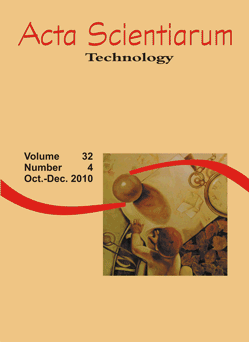<b>Use of activated charcoal and ion-exchange resin to cleaN up and concentrate enzymes in extracts from biodegraded wood</b> - 10.4025/actascitechnol.v32i4.5671
DOI:
https://doi.org/10.4025/actascitechnol.v32i4.5671Keywords:
Ceriporiopsis subvermispora, Eucalyptus grandis, Manganese peroxidasesAbstract
Ceriporiopsis subvermispora was used for the biodegradation of Eucalyptus grandis chips in the presence or absence of co-substrates (glucose and corn steep liquor) during 7, 14 and 28 days. Afterwards, the biodegraded chips were extracted with 50 mM sodium acetate buffer (pH 5.5) supplemented with 0.01% Tween 60. High activities of manganese peroxidases (MnPs) were observed in all the extracts, both in the absence (430, 765 and 896 UI kg-1, respectively) and in the presence of co-substrates (1,013; 2,066 and 2,323 UI kg-1, respectively). The extracts presented a high ratio between absorbances at 280 and 405 nm, indicating a strong abundance of aromatic compounds derived from lignin over heme-peroxidases. Adsorption into activated charcoal showed to be an adequate strategy to reduce the absorbance at 280 nm in all the extracts. Moreover, it allowed to maximize the capacity of an anion exchange resin bed (DEAE-Sepharose) used to concentrate the MnPs present in the extracts. It was concluded that the use of activated charcoal followed by adsorption into DEAE Sepharose is a strategy that can be used to concentrate MnPs in extracts obtained during the biodegradation of E. grandis by C. subvermispora.Downloads
Download data is not yet available.
Downloads
Published
2010-12-02
How to Cite
Carvalho, W., Ferraz, A., & Milagres, A. M. F. (2010). <b>Use of activated charcoal and ion-exchange resin to cleaN up and concentrate enzymes in extracts from biodegraded wood</b> - 10.4025/actascitechnol.v32i4.5671. Acta Scientiarum. Technology, 32(4), 347–354. https://doi.org/10.4025/actascitechnol.v32i4.5671
Issue
Section
Biotechnology
License
DECLARATION OF ORIGINALITY AND COPYRIGHTS
I Declare that current article is original and has not been submitted for publication, in part or in whole, to any other national or international journal.
The copyrights belong exclusively to the authors. Published content is licensed under Creative Commons Attribution 4.0 (CC BY 4.0) guidelines, which allows sharing (copy and distribution of the material in any medium or format) and adaptation (remix, transform, and build upon the material) for any purpose, even commercially, under the terms of attribution.
Read this link for further information on how to use CC BY 4.0 properly.











8.png)




